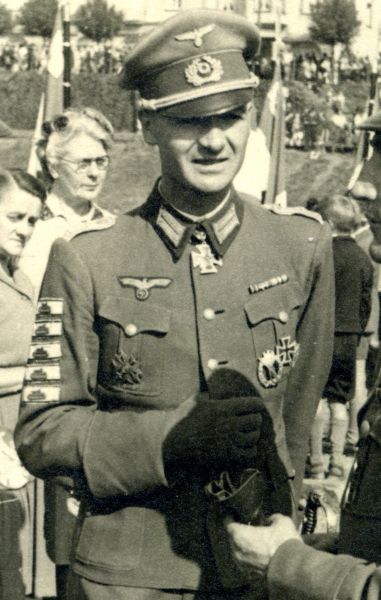Kiesgen, Peter
- Date of birth:
- November 22nd, 1915 (Lieser/Bernkastel-Kues)
- Date of death:
- March 22nd, 1946 (Lieser/Bernkastel-Kues)
- Nationality:
- German
Biography
Do you have more information about this person? Inform us!
- Period:
- Second World War (1939-1945)
- Rank:
- Leutnant (2nd Lieutenant)
- Unit:
- Führer 1. / Infanterie-Regiment 239
- Awarded on:
- October 5th, 1941
“Leutnant Peter Kiesgen (Kompanie commander in an Infanterie-Regiment) has repeatedly distinguished himself in the war against the Soviet Union on account of his outstanding bravery and leadership qualities. On the 30.07.1941 he decided to lead his Kompanie in an attack against a Soviet assembly area in order to attain a more favourable defensive position for his own unit. This attack met with great success, and in the process he and his men captured 9 artillery pieces, 7 heavy machine-guns, 17 machine-guns, 9 heavy mortars, 8 light mortars and abundant quantities of ammunition and communications equipment.
On the 12.08.1941 he eliminated an enemy tank that was advancing towards his Kompanie command post with all guns blazing by throwing a grenade into its turret hatch.
On the 20.08.1941 he knocked out 4 Soviet tanks whilst his Bataillon was in the process of launching a counterattack. He took out 3 of these by climbing onto them and eliminating their crews via throwing hand grenades through the turret hatches. At the fourth tank he stuck a hand grenade into the barrel of the main gun after it had discharged, and the barrel was consequently wrecked. He then killed the dismounting enemy crew with his machine-pistol. Although he received a shoulder wound in the process he remained with his unit, and after all the officers of the Bataillon staff as well as two Kompanie commanders had become casualties he took over the Bataillon and led it until the evening hours, by which time the situation had been resolved and the sector brought firmly under German control.”
- Period:
- Second World War (1939-1945)
- Period:
- Second World War (1939-1945)
- Period:
- Second World War (1939-1945)
- Period:
- Second World War (1939-1945)
- Period:
- Second World War (1939-1945)
- Period:
- Second World War (1939-1945)
- Period:
- Second World War (1939-1945)
- Period:
- Second World War (1939-1945)
Sources
- Photo 1: Jacques
- - FELLGIEBEL, W.P., Elite of theThird Reich, Helion & Company Limited, Solihull, 2003.
- Bender R.J., Breyette T., Tank Killers, RJ Bender Publications, 2000, ISBN 0-912138-83-1
- Photo via Axis History Biographical Research via Axis History Forum
- Der Führer: Das Hauptorgan der NSDAP Gau Baden (Edition 281)










